There are many green fruits in the world of produce.
And while you’ve likely heard of and eaten grapes and limes, I bet there’s a few here you don’t know.

From sweet and sour to everything in between, green fruits are everywhere.
I’m talking about crispy green apples, juicy kiwis, buttery pears, and more.
But did you know that avocado, zucchini, and tomatoes are all classed as fruits?
It’s true! That’s why this list of green fruits is so interesting.
Let’s get to it!
33 Types of Green Fruits

1. Avocados
Yup. Avocados are fruits.
And these pretty, creamy, and versatile fruits are jam-packed with nutrients, including vitamin C, folate, and potassium.
They’re also a terrific source of healthy fats and fiber.
A ripe avocado is firm with some give when you press on the outside.
Meanwhile, the inside is a beautiful green color, and the texture is soft and creamy.
Probably best known for guacamole and avocado toast, they’re a must-have in any kitchen.
Slice them into salads, mash them in your burger buns, or even blend them into smoothies.

2. Kiwi
Kiwis are sweetly-tart, fun, and tasty.
They’re oval, almost egg-shaped fruits with brown, fuzzy skin. And when you cut them open, you’ll see bright green flesh with striking black seeds.
Depending on how ripe they are, kiwis can taste similar to strawberries, bananas, and pineapple.
Nutritionally, they’re a great source of vitamin C and have lots of antioxidants.
Enjoy kiwis on their own, or add them to smoothies and parfaits.

3. Green Apple
Green apples tend to be tart and crisp, unlike some sweeter apples.
They have a bright green, waxy skin that’s easy to spot, they’re high in fiber, and are rich in vitamins C and A.
Granny Smiths are the most well-known, and they’re one of the best baking apples around due to their texture.
Unlike other, less acidic types, green apples won’t turn to mush in the oven. So use them in tarts and pies, or dip them in peanut butter for a snack.

4. Green Grapes
Green grapes are small berries that grow on vines in bunches. They’re sometimes called ‘white’ grapes and are the most popular grape variety.
Most green grapes have bright green skin with a little bit of shine and are long ovals or round.
Grapes make a fantastic snack and can also be sliced into salads or used in parfaits.
Add them to your next charcuterie board for a touch of sweet freshness.

5. Green Pears
Green pears are delicious fruits that are abundant during the colder months.
And while there are many varieties, ranging from white to red, green is the most well-known.
Most pears have a distinct shape: round and wide at the bottom with a tapered top. The flesh is usually soft, buttery, and super juicy.
Each pear variety has different textures, but firmer pears are great for poaching and baking.
In contrast, soft pears are lovely in sandwiches, salads, or snacks!

6. Gooseberries
Gooseberries are another type of berry that’re similar to grapes. They’re small and round with light green, often transparent skin.
These tiny fruits have a super tart flavor with soft flesh. But before you pop one in your mouth, remember that gooseberries also have lots of tiny seeds.
Since they’re super sour, it’s best to cook or sweeten gooseberries in jams and tarts. Or add them to sauces or chutneys or blend them into smoothies.

7. Honeydew Melon
Honeydew is a type of melon most closely related to the cantaloupe.
The outer rind is pale green with an almost scale-like texture. Meanwhile, the flesh is light green-white with yellow-brown seeds.
This fruit is very sweet, and the flesh is soft when ripe.
Honeydew melons have many seeds, but you can easily scoop them out with a spoon after slicing.
Cut up these sweet melons and enjoy them as a snack. Or add them to smoothies and salads.

8. Mexican Sour Cucumber
These tiny fruits have a bit of a confusing name.
Mexican sour cucumbers are actually really sweet when they’re ripe. And they sometimes taste like a cross between a cucumber and a lemon.
They look like mini watermelons but are only about the size of grapes.
These small fruits also grow on vines and are best eaten as a snack or sliced into salads!

9. Limes
Limes are a common citrus fruit readily available in every grocery store or supermarket.
Unlike lemons, which are tart and yellow, limes are smaller with deep green skins and a slightly sweeter taste.
These sweet-sour fruits can be used in all kinds of recipes, including pies, tarts, cakes, and more.
Limes are often used in Indian and Mexican cuisines as well as cocktails.

10. Sour Green Plums
These may look like green apples, but they’re actually sour green plums.
They’re pretty small with a tart flavor and have smooth green skins. The flesh is a light green color with a white pit in the middle.
Unfortunately, these fruits are usually way too sour to eat raw, so they are not suitable for snacking.
However, they make great additions to relishes and sauces. So use them to add tartness to lots of different foods.

11. Guava
Guavas are a gorgeous tropical fruit with lots of flavor.
They have green skin and bright red or pink flesh that’s sweetly sour, like a cross between a strawberry and a pear.
This bright and sweet fruit has lots of vitamin C – more than a whole orange – and tons of antioxidants.
Use them in smoothies for an on-the-go boost of nutrients and flavor!

12. Ugli Fruit
The ugli fruit gets a bad rap.
I think it looks like a cross between a grapefruit and an orange. And while the bumpy green skin may not be perfect, it’s not ugly!
It’s usually about the size of a grapefruit and has citrusy flesh that’s super juicy.
In terms of flavor, it’s tarter than an orange but sweeter than a grapefruit. You can enjoy ugli fruit just as you would most citrus fruits.

13. Starfruit
Starfruit is always a fun and pretty treat. And as the name suggests, it looks like a star when sliced.
When at their peak, starfruits are actually yellow with light green patches. However, eating it while it’s still green is safe and yummy too.
Star fruit can be eaten raw once the seeds are removed. Use it to add a decorative and delicious flair to smoothie bowls or breakfast buffets.
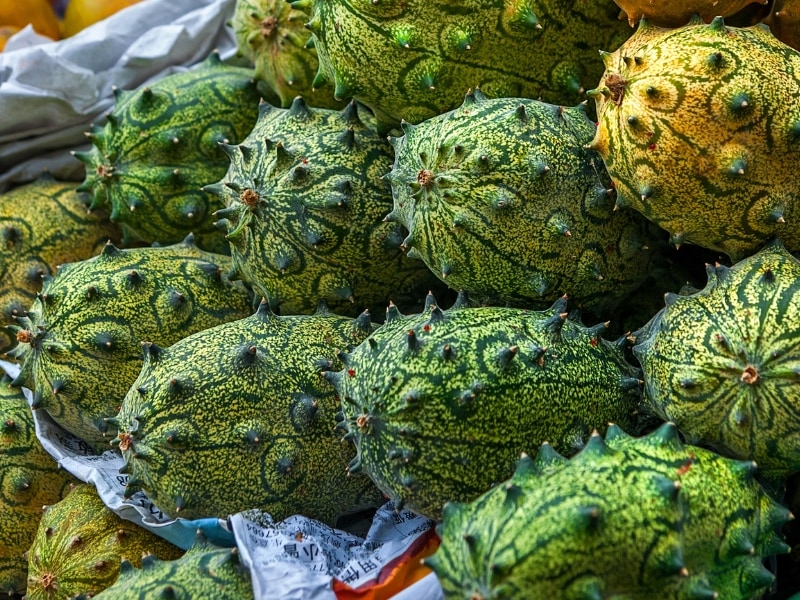
14. Green Kiwano
Kiwanos are also known as the horned melon. They have green or yellow outer skin with horned spines – hence the name.
Green kiwanos have green flesh with an interesting flavor that’s a bit like a cross between a cucumber, zucchini, and a kiwi.
As it ripens, it can taste similar to a banana.
Scoop the pulp of a kiwano from the rind and eat it raw or cooked. Add it to smoothies, yogurt, or ice cream!

15. Cucumbers
Although they’re usually thought of as veggies, cucumbers are refreshing fruits. In fact, they’re technically a type of berry.
Cucumbers are long, cylindrical fruits with light green flesh and deep green skin. They have lots of edible seeds and a very mild flavor.
Crisp and sometimes bitter, they’re often used in salads and cocktails.

16. Custard Apple
Custard apples, also known as custard fruits, are a unique and interesting food.
These green fruits have thick, bumpy, and leathery skin and look similar to a small green pinecone.
At first glance, custard apples don’t seem edible. However, they have creamy flesh with a pleasant tropical flavor.
Unfortunately, custard apples have black seeds in the flesh, which are highly toxic.
So be sure to remove them before enjoying this fruit as a snack.
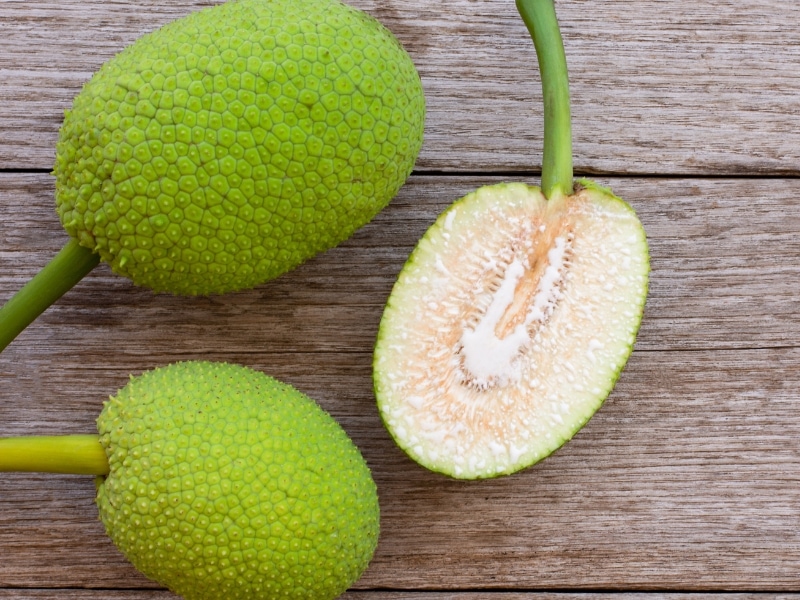
17. Breadfruit
Breadfruit is a tropical fruit that gets its name from its appearance.
Although it’s a green fruit, the skin turns greenish-yellow and brown as it matures.
Due to the skin’s bumpy texture, it looks a bit like bread.
It’s also known to have a bit of a starchy flavor, like a potato.
You can eat breadfruit raw or add it to various desserts.

18. Noni
Noni is another unique tropical fruit that has very bumpy skin.
It is often a pale yellow-green color with an oval shape and can grow to be around seven inches long.
One key thing to remember before bringing noni home, though, is that they can end up smelling like mature cheese!
The flesh of noni fruits is bitter and has a pungent odor. It’s best cut into chunks and fried in coconut milk with spices.
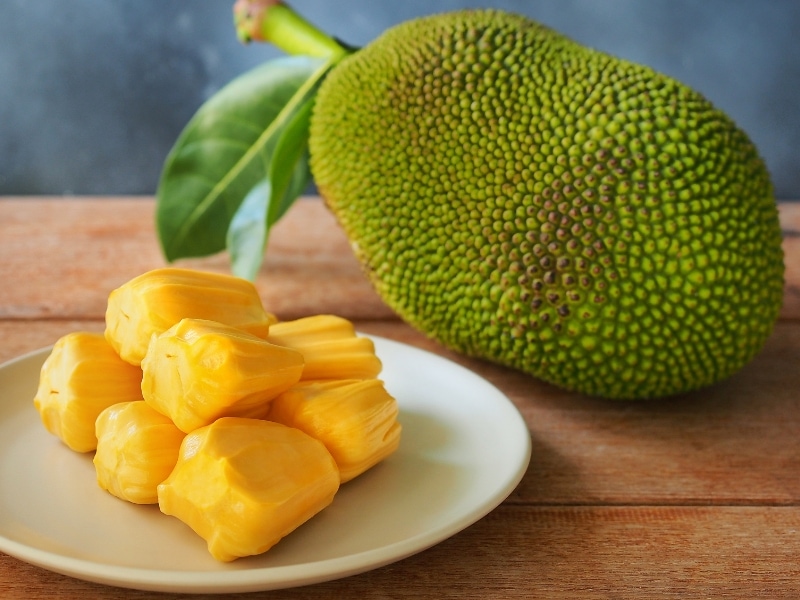
19. Jackfruit
It’s been said that the jackfruit will be one of the solutions to world hunger.
This huge fruit can grow up to two feet long, with the biggest weighing about 40 pounds.
Inside the jackfruit is a whole bunch of small bulbs of flesh. They have a dense and fibrous texture similar to bananas, mangoes, or pineapples.
Jackfruit has a mildly sweet flavor and resembles pulled pork when it’s cooked and shredded, making it a great vegan option.

20. Durian Fruit
Durian is a tropical tree fruit that looks similar to jackfruit but is often smaller.
These spiky greenish-yellow fruits have a very distinct appearance and flavor – and that’s not always a good thing.
The flesh of the durian fruit can be very creamy – similar to cheesecake. But the taste and smell are somewhat controversial.
Some say the durian fruit tastes like caramel and vanilla. Others claim the odor is similar to rotten onions.
Many find the smell overwhelming, which is why this fruit is banned on public transport and in hotels in many countries.

21. Soursop
Soursop is a spiny green tropical fruit that’s a staple in the Caribbean and Southeast Asia.
This fruit is green on the outside with pure white flesh and a pineapple aroma.
The flavor is a sweet and fruity mix of strawberries and apples with some citrusy undertones.
But it’s another fruit with toxic black seeds, so be sure to discard them before slicing them and adding them to fruit salads.

22. Osage Orange
Despite its name, this fruit is green, and it’s not a citrus fruit!
Osage oranges are part of the mulberry family and are rarely eaten. They have very bumpy bright green skin, and the flesh is yellow and juicy.
If you do decide to take a bite, expect a cucumber-like flavor.
That said, they’re not usually consumed, though they can be used to make tea.

23. Cucamelon
The cucamelon is a small green fruit from Central America and Mexico.
They were initially known as sandia manzana, which means ‘apple watermelon’ in English.
Cucamelons are shaped like a cucumber, and the skin resembles a honeydew.
The flesh is bright white and tastes nice and sweet. It is sometimes compared to pears or apples.
Eat them raw, like grapes, pickle them, or add them to salads, salsas, and more.

24. Zucchini
Since it holds its own seeds, zucchini is botanically a fruit.
Still, they’re most commonly used in savory dishes because they easily absorb the flavor of other things they’re cooked with.
Zucchinis are green on the outside and are easily confused with a cucumber. The flesh of a zucchini, however, is less juicy and denser.
It’s a type of squash that is versatile in cooking. Steam it, sauté it, boil it, or grill it.
Or go crazy and add it to pumpkin bread! It acts like shredded carrot – bringing moisture but little to no flavor.
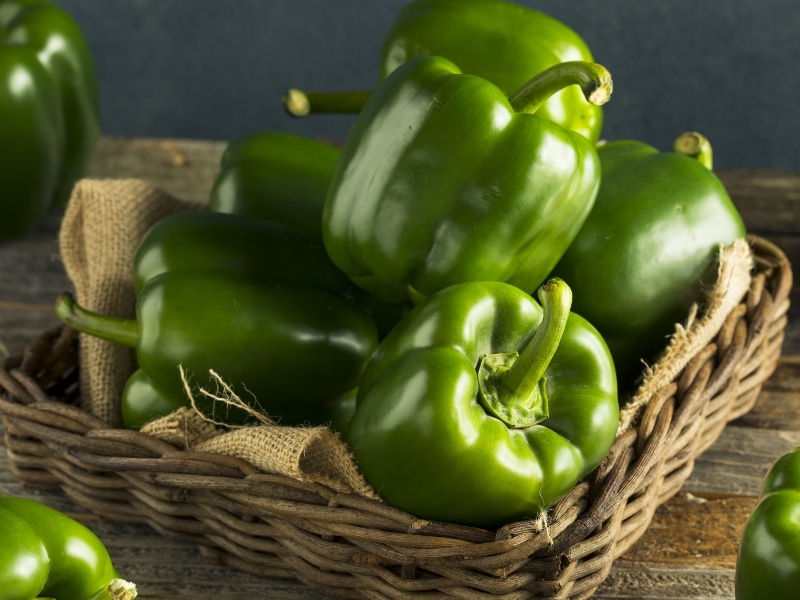
25. Green Pepper
Yes, peppers are also a type of fruit because they have seeds in the middle and grow from the flower of the pepper plant.
Green peppers (bell peppers) are a type of sweet pepper with tiny seeds and shiny green skin.
Since they’re sweet, they’re low on the Scoville heat index. That means they can be eaten raw or cooked.
Add these to salads, sandwiches, soups, sauces, and more!

26. Cam Sành (Terracotta Orange)
Cam Sånh is a hybrid citrus fruit from Vietnam, and it’s actually the most popular type of orange in Cambodia and Vietnam.
It’s similar to a mandarin orange but has a green outer skin. The flesh is dark orange and wonderfully sweet.
Eat them how you would any citrus fruit.

27. Calamansi (Calamondin)
Calamansi (calamondin) has many names and is native to the Philippines. It’s also sometimes called the Philippine lime or Philippine lemon.
These oranges are dark green on the outside and bright orange on the inside.
Though they can occasionally be found with a light to bright orange-green outside, too.
The flavor is an extra tart combination of lemon, lime, and orange, so they’re in drinks and salads.

28. Chayote
Chayote looks similar to a pear and has bright green skin. But despite its appearance, it’s more closely related to squash than a pear.
The flesh of these fruits is a light green to white and tastes rather mild. That’s why it’s most often used like a vegetable in most recipes.
Season it with salt and pepper and serve it roasted or sautéed.

29. Green Tomato
There are two different types of green tomatoes.
Heirloom tomatoes are green when fully ripe, whereas regular unripe tomatoes are harvested while they’re still green (before changing colors).
While heirloom tomatoes have tons of vitamins and nutrients, unripe tomatoes are not as nutrient-rich.
But both are great for eating and make wonderful additions to salads and tarts because of their colors and shapes.
Unripe tomatoes will be more acidic since they’re still ripening. But they are incredible in the famous dish, fried green tomatoes.

30. Green Mangoes
This mango variety is sweet, juicy, and delicious. It’s a staple in Asian cuisine and can be found in candies, desserts, and juice.
Green mangoes are oblong with green skins and pale yellow flesh.
They can sometimes be slightly sour and have a fibrous and dense texture.
Enjoy green mangoes on their own, in salads, or on top of ice cream.

31. Greengage Plums
These plums have a greenish hue and are popular in the fall months.
They’re usually harvested at the end of September and have a delightful strawberry-like flavor.
I think they taste amazing paired with peaches and apricots. And during canning season, greengage plums are excellent for jams and jellies.
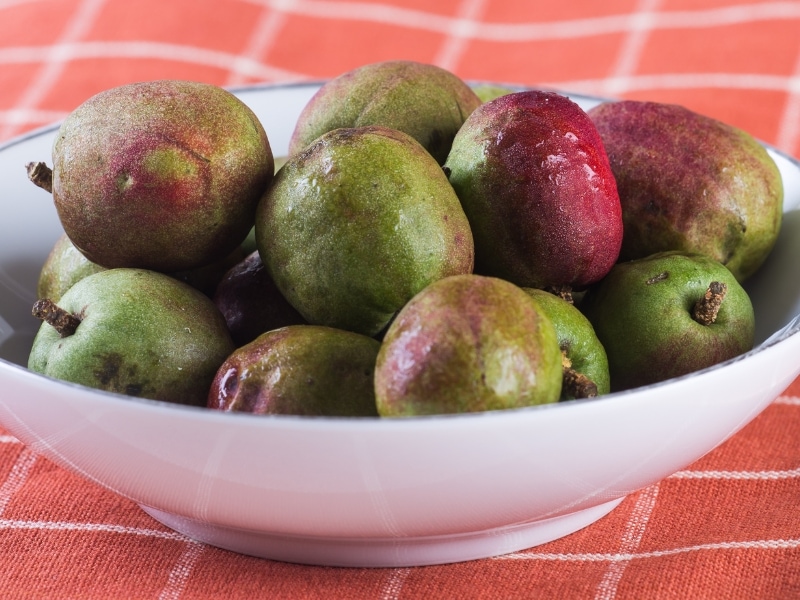
32. Jocote
Jocote fruits are small green fruits with large pits inside.
They’re often found in tropical regions and throughout Central America and are slightly sweet with a soft plum flavor.
On the tree, they have leaves similar to limes, so you may have to look closely to distinguish between the fruits.
Enjoy jocote fruits fried in bacon grease for a salty-sweet treat.

33. Pomelo
Pomelos are large citrus fruits with a delicious sweet flavor.
They look a lot like grapefruits and have similar flavors, only without the extra bitterness.
The light green skin of a pomelo is super thick with white pith. The inside flesh is a juicy and vibrant pink.
Pomelos grow in tropical regions and can be used in various ways.
Use them in sweet desserts or to make marmalade. You can also just scoop the flesh and snack on them raw.










